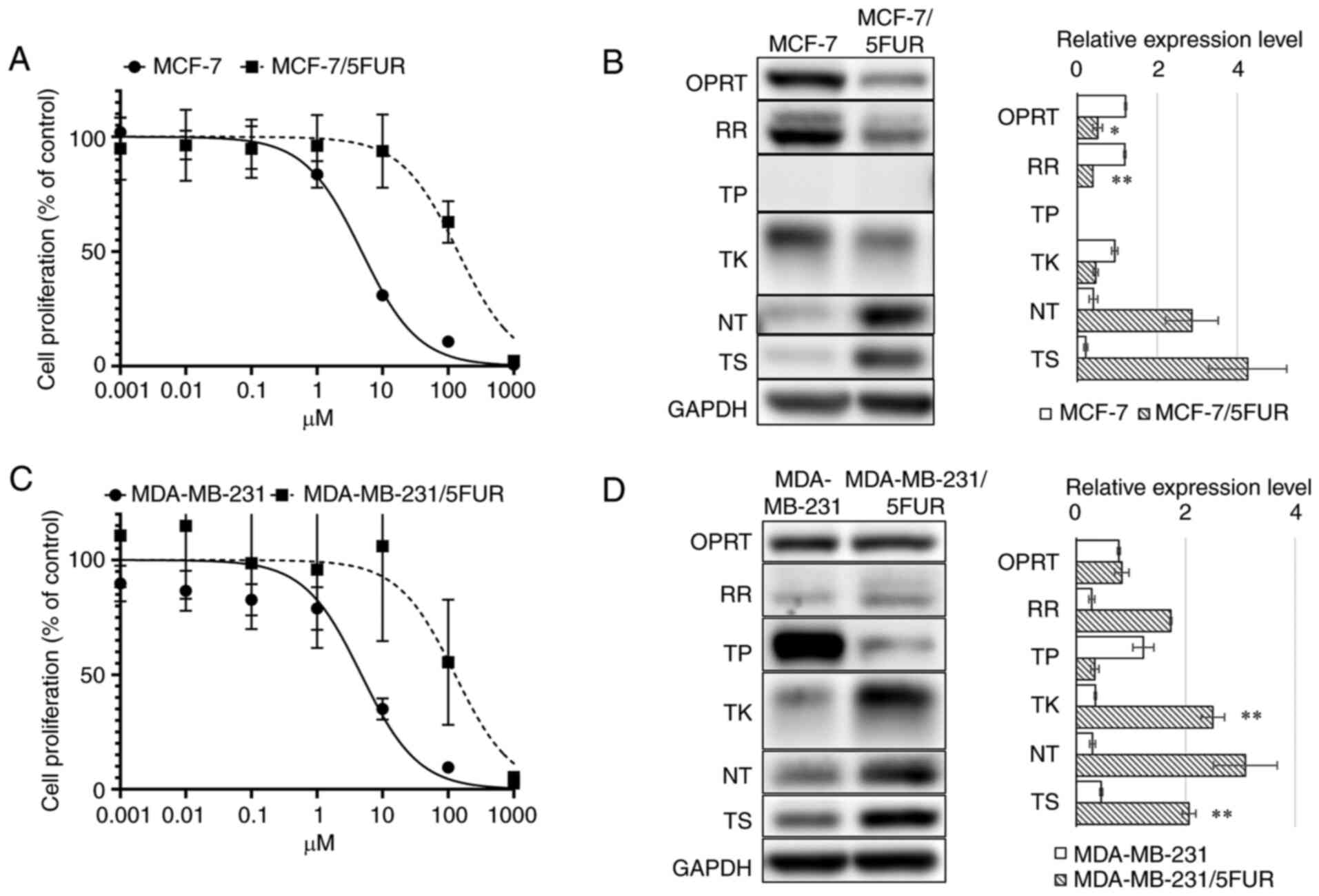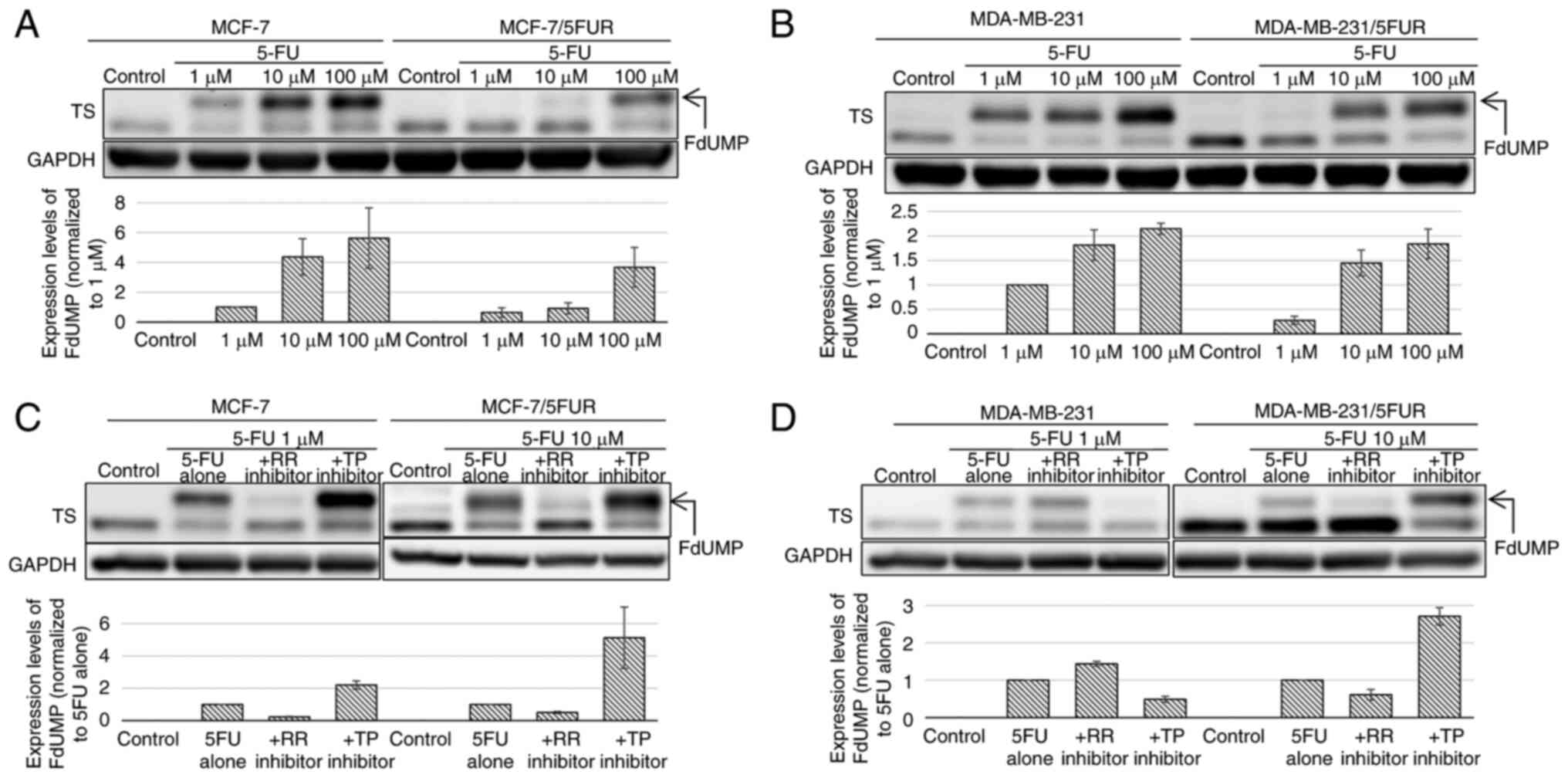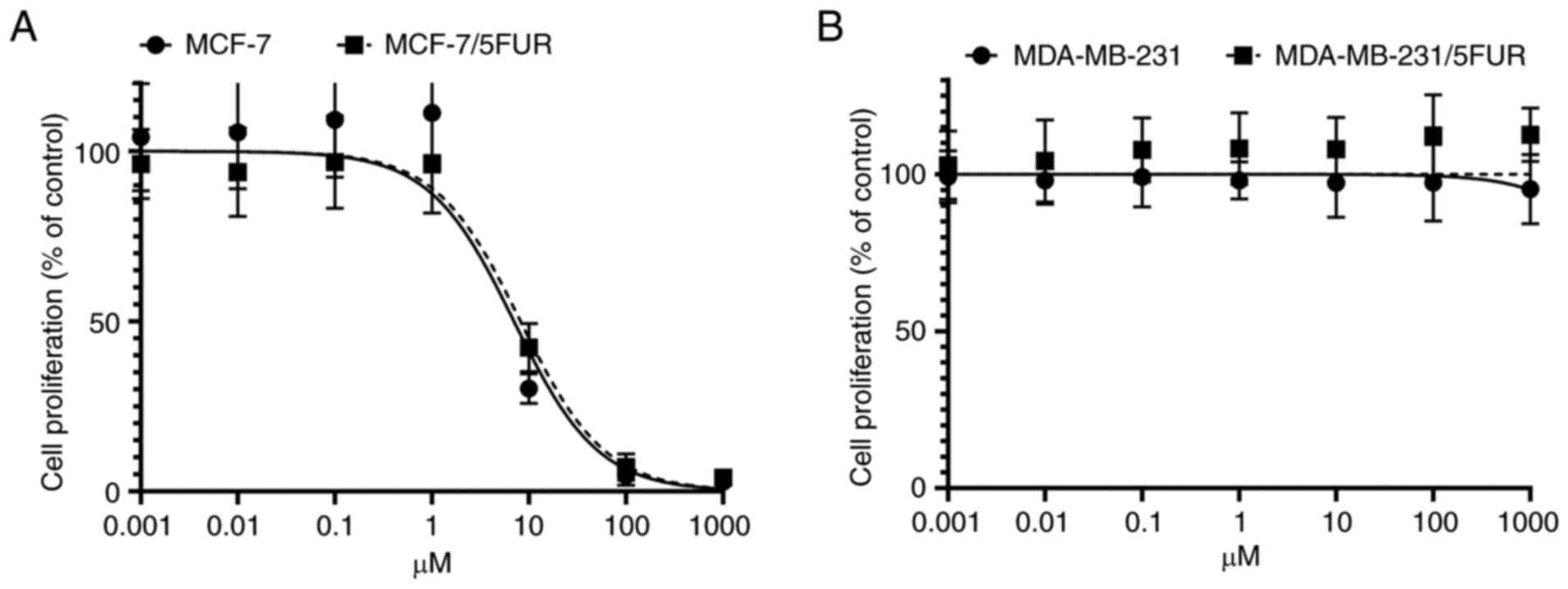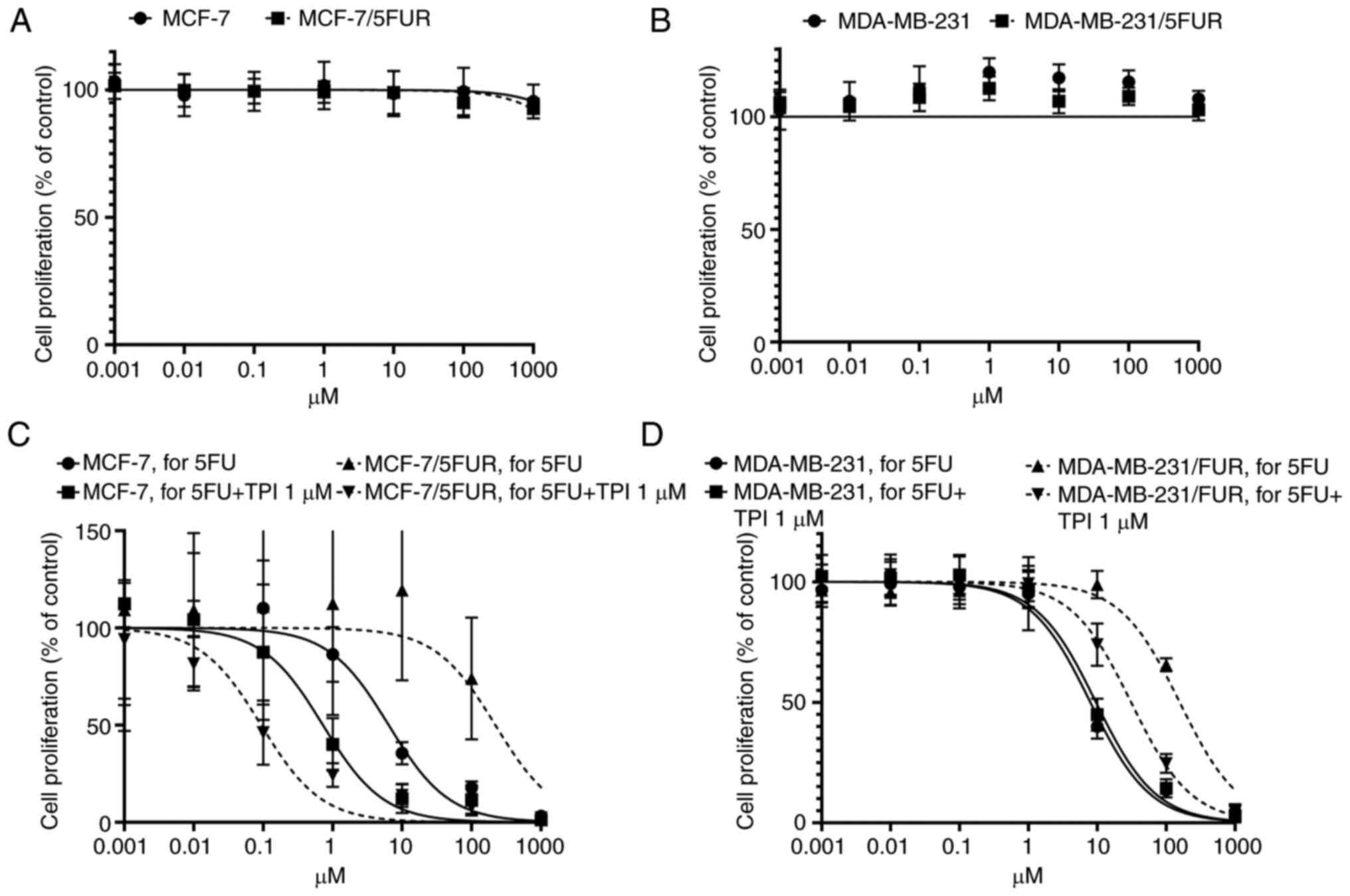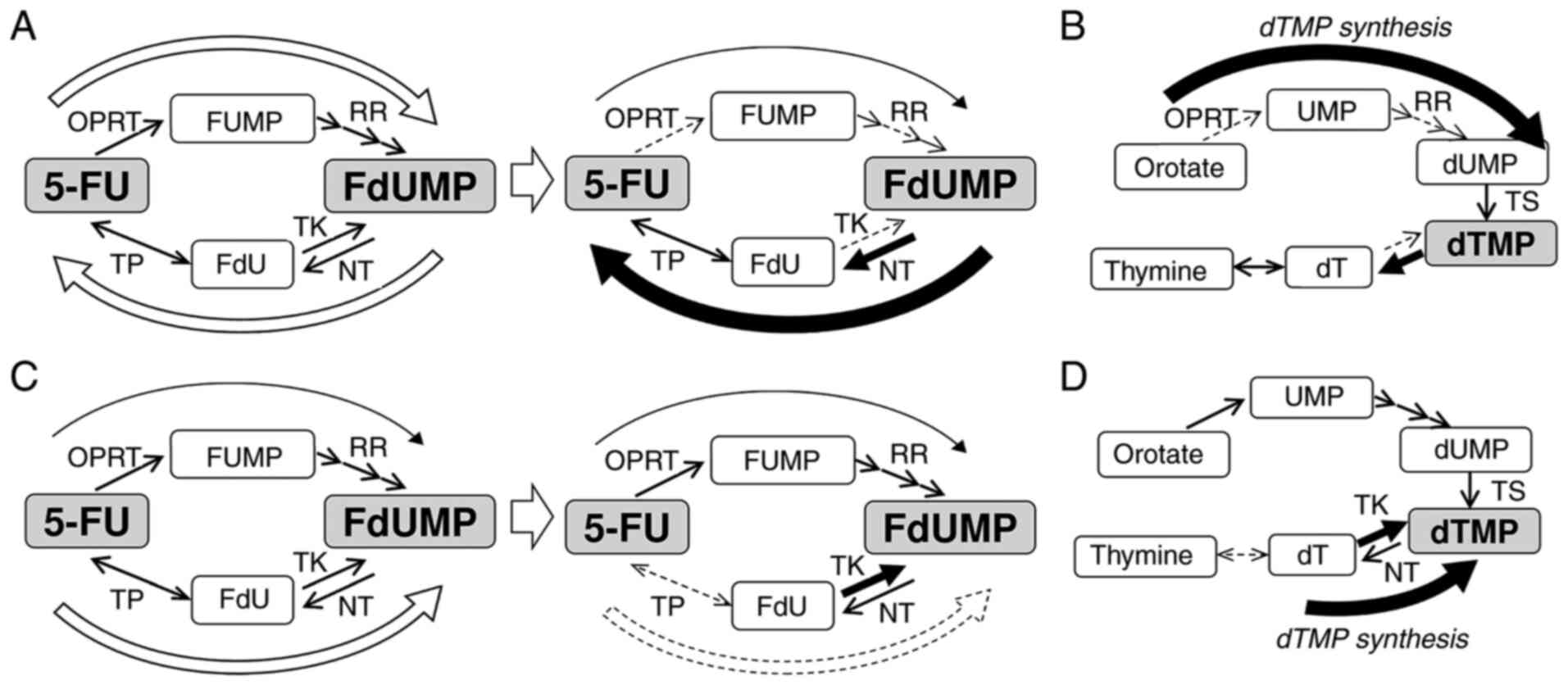|
1
|
Sung H, Ferlay J, Siegel RL, Laversanne M,
Soerjomataram I, Jemal A and Bray F: Global cancer statistics 2020:
GLOBOCAN estimates of incidence and mortality worldwide for 36
cancers in 185 countries. CA Cancer J Clin. 71:209–249. 2021.
View Article : Google Scholar : PubMed/NCBI
|
|
2
|
Longley DB, Harkin DP and Johnston PG:
5-fluorouracil: Mechanisms of action and clinical strategies. Nat
Rev Cancer. 3:330–338. 2003. View
Article : Google Scholar : PubMed/NCBI
|
|
3
|
Toi M, Imoto S, Ishida T, Ito Y, Iwata H,
Masuda N, Mukai H, Saji S, Shimizu A, Ikeda T, et al: Adjuvant S-1
plus endocrine therapy for oestrogen receptor-positive,
HER2-negative, primary breast cancer: A multicentre, open-label,
randomised, controlled, phase 3 trial. Lancet Oncol. 22:74–84.
2021. View Article : Google Scholar
|
|
4
|
Masuda N, Lee SJ, Ohtani S, Im YH, Lee ES,
Yokota I, Kuroi K, Im SA, Park BW, Kim SB, et al: Adjuvant
capecitabine for breast cancer after preoperative chemotherapy. N
Engl J Med. 376:2147–2159. 2017. View Article : Google Scholar : PubMed/NCBI
|
|
5
|
Takashima T, Mukai H, Hara F, Matsubara N,
Saito T, Takano T, Park Y, Toyama T, Hozumi Y, Tsurutani J, et al:
Taxanes versus S-1 as the first-line chemotherapy for metastatic
breast cancer (SELECT BC): An open-label, non-inferiority,
randomised phase 3 trial. Lancet Oncol. 17:90–98. 2016. View Article : Google Scholar
|
|
6
|
Kufe DW and Major PP: 5-Fluorouracil
incorporation into human breast carcinoma RNA correlates with
cytotoxicity. J Biol Chem. 256:9802–9805. 1981. View Article : Google Scholar : PubMed/NCBI
|
|
7
|
Saito K, Nagashima H, Noguchi K, Yoshisue
K, Yokogawa T, Matsushima E, Tahara T and Takagi S: First-in-human,
phase I dose-escalation study of single and multiple doses of a
first-in-class enhancer of fluoropyrimidines, a dUTPase inhibitor
(TAS-114) in healthy male volunteers. Cancer Chemother Pharmacol.
73:577–83. 2014. View Article : Google Scholar
|
|
8
|
Francini G, Petrioli R, Lorenzini L,
Mancini S, Armenio S, Tanzini G, Marsili S, Aquino A, Marzocca G,
Civitelli S, et al: Folinic acid and 5-fluorouracil as adjuvant
chemotherapy in colon cancer. Gastroenterology. 106:899–906. 1994.
View Article : Google Scholar : PubMed/NCBI
|
|
9
|
Goodsell DS: The molecular perspective:
methotrexate. Oncologist. 4:340–341. 1999. View Article : Google Scholar
|
|
10
|
Rose MG, Farrell MP and Schmitz JC:
Thymidylate synthase: A critical target for cancer chemotherapy.
Clin Colorectal Cancer. 1:220–229. 2002. View Article : Google Scholar : PubMed/NCBI
|
|
11
|
Wolmark N, Rockette H, Fisher B, Wickerham
DL, Redmond C, Fisher ER, Jones J, Mamounas EP, Ore L, Petrelli NJ,
et al: The benefit of leucovorin-modulated fluorouracil as
postoperative adjuvant therapy for primary colon cancer: Results
from national surgical adjuvant breast and bowel project protocol
C-03. J Clin Oncol. 11:1879–1887. 1993. View Article : Google Scholar
|
|
12
|
Hironaka S, Sugimoto N, Yamaguchi K,
Moriwaki T, Komatsu Y, Nishina T, Tsuji A, Nakajima TE, Gotoh M,
Machida N, et al: S-1 plus leucovorin versus S-1 plus leucovorin
and oxaliplatin versus S-1 plus cisplatin in patients with advanced
gastric cancer: A randomised, multicentre, open-label, phase 2
trial. Lancet Oncol. 17:99–108. 2016. View Article : Google Scholar
|
|
13
|
Drake JC, Allegra CJ and Johnston PG:
Immunological quantitation of thymidylate
synthase-FdUMP-5,10-methylenetetrahydrofolate ternary complex with
the monoclonal antibody TS 106. Anticancer Drugs. 4:431–435. 1993.
View Article : Google Scholar : PubMed/NCBI
|
|
14
|
MacFarlane AJ, Anderson DD, Flodby P,
Perry CA, Allen RH, Stabler SP and Stover PJ: Nuclear localization
of de novo thymidylate biosynthesis pathway is required to prevent
uracil accumulation in DNA. J Biol Chem. 286:44015–44022. 2011.
View Article : Google Scholar : PubMed/NCBI
|
|
15
|
Kodera Y, Ito S, Fujiwara M, Mochizuki Y,
Nakayama G, Ohashi N, Koike M, Yamamura Y and Nakao A: Gene
expression of 5-fluorouracil metabolic enzymes in primary gastric
cancer: Correlation with drug sensitivity against 5-fluorouracil.
Cancer Lett. 252:307–313. 2007. View Article : Google Scholar
|
|
16
|
Tsutani Y, Yoshida K, Sanada Y, Wada Y,
Konishi K, Fukushima M and Okada M: Decreased orotate
phosphoribosyltransferase activity produces 5-fluorouracil
resistance in a human gastric cancer cell line. Oncol Rep.
20:1545–1551. 2008.PubMed/NCBI
|
|
17
|
Isshi K, Sakuyama T, Gen T, Nakamura Y,
Kuroda T, Katuyama T and Maekawa Y: Predicting 5-FU sensitivity
using human colorectal cancer specimens: comparison of tumor
dihydropyrimidine dehydrogenase and orotate phosphoribosyl
transferase activities with in vitro chemosensitivity to 5-FU. Int
J Clin Oncol. 7:335–342. 2002. View Article : Google Scholar
|
|
18
|
Yoshino T, Mizunuma N, Yamazaki K, Nishina
T, Komatsu Y, Baba H, Tsuji A, Yamaguchi K, Muro K, Sugimoto N, et
al: TAS-102 monotherapy for pretreated metastatic colorectal
cancer: A double-blind, randomised, placebo-controlled phase 2
trial. Lancet Oncol. 13:993–1001. 2012. View Article : Google Scholar
|
|
19
|
Shitara K, Doi T, Dvorkin M, Mansoor W,
Arkenau HT, Prokharau A, Alsina M, Ghidini M, Faustino C, Gorbunova
V, et al: Trifluridine/tipiracil versus placebo in patients with
heavily pretreated metastatic gastric cancer (TAGS): A randomised,
double-blind, placebo-controlled, phase 3 trial. Lancet Oncol.
19:1437–1448. 2018. View Article : Google Scholar
|
|
20
|
Mori R, Futamura M, Tanahashi T, Tanaka Y,
Matsuhashi N, Yamaguchi K and Yoshida K: 5FU resistance caused by
reduced fluoro-deoxyuridine monophosphate and its reversal using
deoxyuridine. Oncol Lett. 14:3162–3168. 2017. View Article : Google Scholar
|
|
21
|
Mori R, Yoshida K, Futamura M, Suetsugu T,
Shizu K, Tanahashi T, Tanaka Y, Matsuhashi N and Yamaguchi K: The
inhibition of thymidine phosphorylase can reverse acquired
5FU-resistance in gastric cancer cells. Gastric Cancer. 22:497–505.
2019. View Article : Google Scholar : PubMed/NCBI
|
|
22
|
Suetsugu T, Mori R, Futamura M, Fukada M,
Tanaka H, Yasufuku I, Sato Y, Iwata Y, Imai T, Imai H, et al:
Mechanism of acquired 5FU resistance and strategy for overcoming
5FU resistance focusing on 5FU metabolism in colon cancer cell
lines. Oncol Rep. 45:272021. View Article : Google Scholar : PubMed/NCBI
|
















